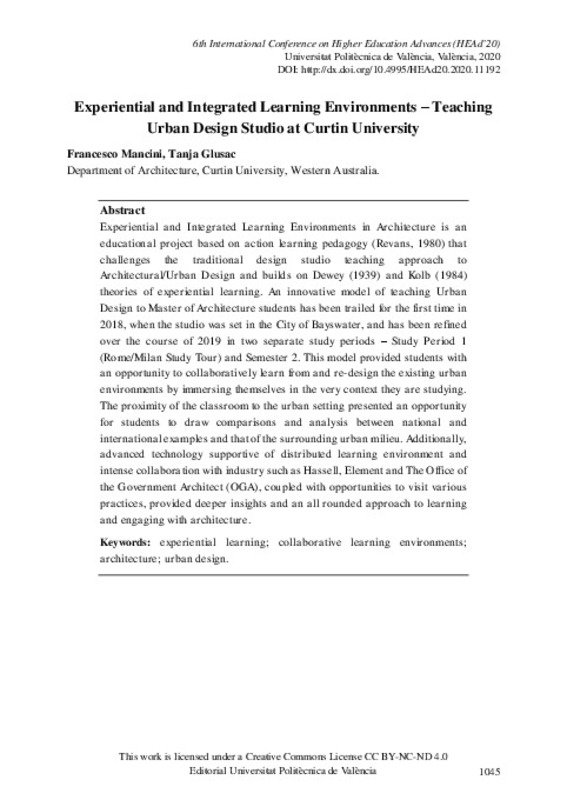JavaScript is disabled for your browser. Some features of this site may not work without it.
Buscar en RiuNet
Listar
Mi cuenta
Estadísticas
Ayuda RiuNet
Admin. UPV
Experiential and Integrated Learning Environments – Teaching Urban Design Studio at Curtin University
Mostrar el registro sencillo del ítem
Ficheros en el ítem
| dc.contributor.author | Mancini, Francesco
|
es_ES |
| dc.contributor.author | Glusac, Tanja
|
es_ES |
| dc.date.accessioned | 2020-06-11T06:57:28Z | |
| dc.date.available | 2020-06-11T06:57:28Z | |
| dc.date.issued | 2020-05-05 | |
| dc.identifier.isbn | 9788490488119 | |
| dc.identifier.issn | 2603-5871 | |
| dc.identifier.uri | http://hdl.handle.net/10251/146075 | |
| dc.description.abstract | [EN] Experiential Learning and Integrated Learning Environments in Architecture is a pedagogic project based on action learning (Revans, 1980) that challenges the traditional design studio teaching approach to Architectural/Urban Design and builds on Dewey (1939) and Kolb (1984) theories of experiential learning. An innovative model of teaching Urban Design to Master of Architecture students has been trailed for the first time in 2018, when the studio was set in the City of Bayswater, and has been refined over the course of 2019 in two separate study periods – Study Period 1 (Rome/Milan Study Tour) and Semester 2. This model provides students with an opportunity to collaboratively learn from and re-design the existing urban environments by immersing themselves in the very context they are studying. The proximity of the classroom to the urban setting presented an opportunity for students to draw comparisons and analysis between national and international examples and that of the surrounding urban milieu. Additionally, advanced technology supportive of distributed learning environment and intense collaboration with industry such as Hassell, Element and The Office of the Government Architect (OGA), coupled with opportunities to visit various practices, provided deeper insights and an all rounded approach to learning and engaging with architecture. Keywords: experiential learning; collaborative learning environments; architecture, urban design | es_ES |
| dc.language | Inglés | es_ES |
| dc.publisher | Editorial Universitat Politècnica de València | es_ES |
| dc.relation.ispartof | 6th International Conference on Higher Education Advances (HEAd'20) | |
| dc.rights | Reconocimiento - No comercial - Sin obra derivada (by-nc-nd) | es_ES |
| dc.subject | Higher Education | es_ES |
| dc.subject | Learning | es_ES |
| dc.subject | Educational systems | es_ES |
| dc.subject | Teaching | es_ES |
| dc.subject | Experiential learning | es_ES |
| dc.subject | Collaborative learning environments | es_ES |
| dc.subject | Architecture | es_ES |
| dc.subject | urban design | es_ES |
| dc.title | Experiential and Integrated Learning Environments – Teaching Urban Design Studio at Curtin University | es_ES |
| dc.type | Capítulo de libro | es_ES |
| dc.type | Comunicación en congreso | es_ES |
| dc.identifier.doi | 10.4995/HEAd20.2020.11192 | |
| dc.rights.accessRights | Abierto | es_ES |
| dc.description.bibliographicCitation | Mancini, F.; Glusac, T. (2020). Experiential and Integrated Learning Environments – Teaching Urban Design Studio at Curtin University. En 6th International Conference on Higher Education Advances (HEAd'20). Editorial Universitat Politècnica de València. (30-05-2020):1045-1053. https://doi.org/10.4995/HEAd20.2020.11192 | es_ES |
| dc.description.accrualMethod | OCS | es_ES |
| dc.relation.conferencename | Sixth International Conference on Higher Education Advances | es_ES |
| dc.relation.conferencedate | Junio 02-05,2020 | es_ES |
| dc.relation.conferenceplace | València, Spain | es_ES |
| dc.relation.publisherversion | http://ocs.editorial.upv.es/index.php/HEAD/HEAd20/paper/view/11192 | es_ES |
| dc.description.upvformatpinicio | 1045 | es_ES |
| dc.description.upvformatpfin | 1053 | es_ES |
| dc.type.version | info:eu-repo/semantics/publishedVersion | es_ES |
| dc.description.issue | 30-05-2020 | |
| dc.relation.pasarela | OCS\11192 | es_ES |








